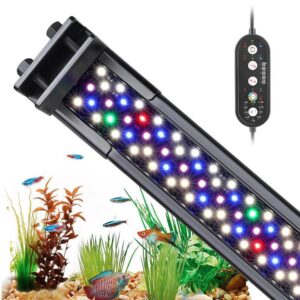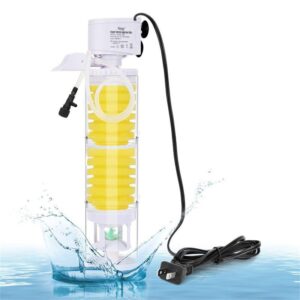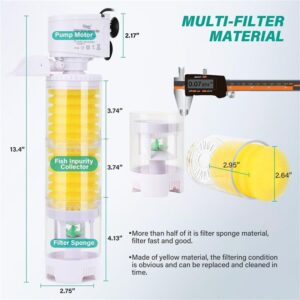How to Plant Hornwort in Aquariums
Hornwort is an appealing freshwater plant, ideal for freshwater aquariums and ponds. It can reach 0.5-1.5 inches on the stem and grow up to 24 inches in length. Also, it is easy to care for in aquariums. So, if you are going to set up a planted aquarium, why not consider Hornwort? And this guide will walk you through some basic information and care tips about Hornwort.
Hornwort care
Get into Hornwort
| Scientific name | Ceratophyllum demersum |
| Common name | Hornwort / rigid hornwort /coontail /coon’s tail |
| Family | Ceratophyllaceae |
| Appearance | With a long green stem, it has branches every inch. The green leaves are thin, and their shapes are like needles. |
| Compatible fish | Goldfish, Guppies, Tetras, Danios, etc. |
| Grow rate | Fast |
| Lighting level | Medium |
| Lighting hours | Approximately 10 hours |
| Light intensity | 20-40 lumens/liter |
| PAR value | 30-80 PAR or 50-120 μmol/s |
| CO2 supplement | Not necessary |
| Necessary maintenance | Trim regularly to control its growth and prevent it from overshadowing other plants |
Roles of Hornwort in aquariums
After a brief introduction, let’s learn what Hornwort does in aquariums.
- Provide shelter
Hornwort can be planted in the substrate, or just float on the water surface. Its dense growth offers hiding places and spawning sites, plus protects small or shy fish. As a floating plant, it can limit algae growth. Because it can block out light.
- Oxygenation
Through photosynthesis, it absorbs carbon dioxide and releases oxygen into the water. This helps to oxygenate the aquarium, providing a healthier environment for fish and other aquatic organisms.
- Nutrient absorption and algae control
Hornwort consumes excess nutrients, such as nitrates, phosphates, and ammonia, from aquarium water. Also, its fast growth rate and ability to shade the water surface can limit the availability of resources for algae, limiting their growth.
- Filtration and water clarity
The dense foliage of Hornwort acts as a natural filter, providing surfaces for beneficial bacteria to grow. Additionally, the fine leaves can help trap suspended particles, which improves water clarity.
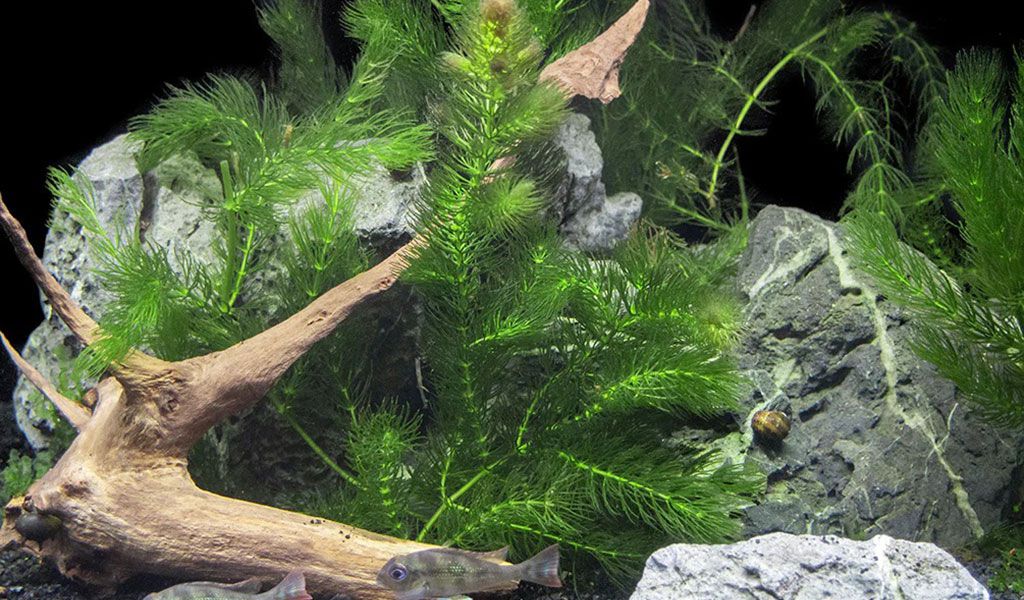
What are the disadvantages of Hornwort?
Fast growth and overgrowth
Hornwort is known for its fast growth rate, which can be both an advantage and a disadvantage. If not properly managed, it can quickly overgrow the aquarium, overshadowing other plants and blocking light. So to prevent imbalances in your tank, prune or trim Hornwort regularly is necessary.
Shedding of fine leaves
Hornwort has fine and delicate leaves that can be shed easily. The shed leaves accumulated in the aquarium will lead to clogged filters or reduced water flow. Thus, to prevent debris buildup and ensure great filtration, you’d better perform regular fish tank cleaning.
Nutrient competition
While Hornwort can help absorb excess nutrients from the water, it also competes with other plants for nutrients. In heavily planted aquariums, Hornwort’s fast growth and nutrient absorption capacity may outcompete other plants. It may limit their growth and potentially and then cause imbalances in the tank’s overall aesthetics and biodiversity.
Invasive potential
Under certain conditions, Hornwort can become invasive. For example, in outdoor ponds or natural water bodies. It can spread rapidly through fragmentation and can adapt to different environments, which may cause uncontrolled growth, increasing the risk of outcompeting native aquatic plants and disrupting local ecosystems.
Bloom hornwort aquarium more
Lighting
Typically, Hornwort can thrive under medium-light conditions. You can consider a full-spectrum aquarium light or LED planted lights. Commonly, Hornwort requires:
- Lighting level: Medium
- Lighting hours: Approximately 10 hours
- Light intensity: 20-40 lumens/liter
- PAR value: 30-80 PAR or 50-120 μmol/s
Water parameters
Hornwort is adaptable to a wide range of water parameters. It can thrive in both soft and hard water and prefers slightly acidic to slightly alkaline water. In general, the ideal water parameters should be:
- Water temperature: 50-85℉
- pH level: 6.0-7.5
- Water hardness: 5-18 dGH
Furthermore, it is recommended to regularly monitor the water parameters with the help of water test strips. It helps to check whether the water condition is stable and appropriate for your aquarium.
Nutrient levels
Hornwort benefits from a balanced nutrient supply. You should ensure adequate levels of macronutrients (e.g. nitrogen, phosphorus, potassium) and micronutrients. Also, if necessary, you can provide liquid fertilizers or root tabs specifically formulated for aquatic plants.
Water flow rate
Hornwort prefers a moderate water flow rate. Just make sure to prevent stagnant water with the help of water circulation in your tank. The water flow rate should not be too strong to cause Hornwort to uproot or break apart.
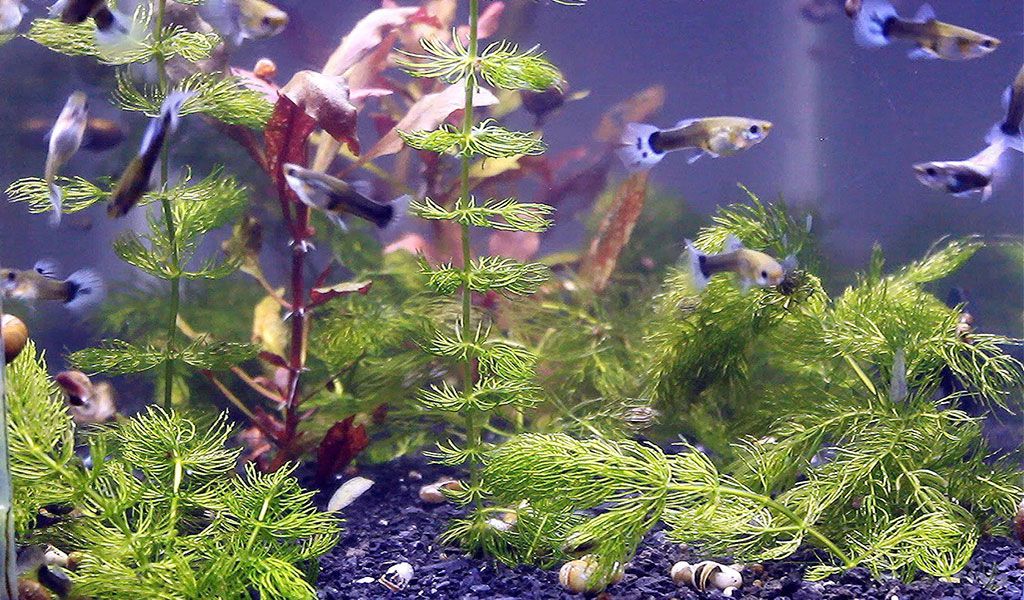
The life cycle of hornworts
Hornworts are a group of non-vascular plants that exhibit a unique life cycle known as alternation of generations. The life cycle of hornworts typically consists of two main stages: the gametophyte stage and the sporophyte stage.
Gametophyte stage
The dominant and persistent stage in the hornwort life cycle is the gametophyte stage. The gametophyte is a small, thalloid (flat and ribbon-like) plant body that grows on a substrate or rocks. It is green and photosynthetic, enabling it to produce its food through photosynthesis.
The gametophyte stage of hornworts has specialized structures called gametophores, which bear the reproductive organs, named antheridia (male reproductive organs) and archegonia (female reproductive organs). The antheridia produce sperm cells, while the archegonia contain egg cells.
Fertilization in hornworts occurs when sperm cells swim through a thin film of water to reach the archegonia and fertilize the egg cells. This fertilization process results in the formation of a zygote.
Sporophyte stage
Once fertilization occurs, the zygote develops into the sporophyte stage. The sporophyte is a short-lived, cylindrical structure that grows vertically from the gametophyte. It depends on the gametophyte for nutrition.
The sporophyte consists of a foot, which is embedded within the gametophyte tissue, and a capsule at the top. The capsule contains spore-producing cells called sporocytes. Within the sporocytes, meiosis occurs, resulting in the production of haploid spores.
When the sporocytes undergo meiosis, they release spores into the environment. These spores are dispersed by wind, water, or other means. If conditions are favorable, the spores can germinate and develop into new gametophytes, completing the life cycle.
Overall, the life cycle of hornworts involves the alternation of generations between the gametophyte and sporophyte stages. The gametophyte is the dominant stage and produces a zygote, while the sporophyte is a temporary structure that produces spores for dispersal and subsequent germination into new gametophytes.
In summary
For less maintenance and a lower care level, Hornwort is ideal for beginners. But taking necessary action to prevent overgrowth is vital. Otherwise, it would be a mess or a nightmare.
That is all for this guide. Thanks for your reading and wish you the best for your aquaristic effort.

